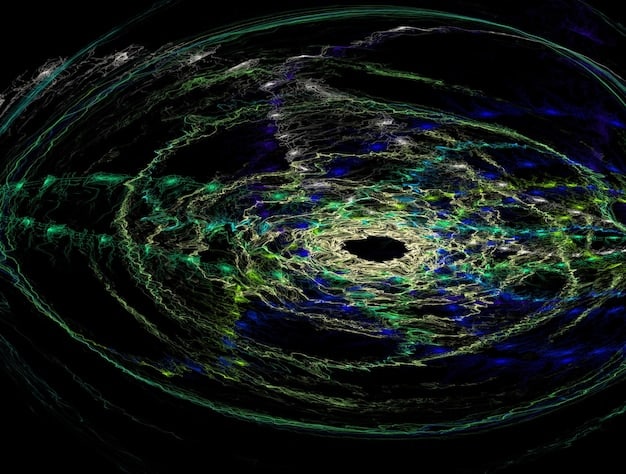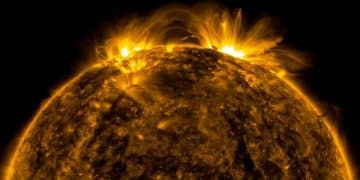Space Weather Forecast 2025: Preparing for Solar Disruptions

Space Weather Forecast 2025 anticipates increased solar activity, potentially disrupting communication systems, power grids, and satellite operations, necessitating preparedness measures for homes and businesses.
The intensity of space weather is on the rise. As we approach 2025, the solar cycle is predicted to reach its peak, increasing the likelihood of significant solar events. Preparing for potential disruptions caused by increased solar activity in the Space Weather Forecast 2025 is crucial for safeguarding our technology and infrastructure.
Understanding Space Weather and Solar Cycles
Space weather refers to the dynamic conditions in the space environment, primarily influenced by the sun. Throughout its 11-year solar cycle, the sun’s activity fluctuates, ranging from relatively quiet periods to intense periods characterized by increased sunspots and solar flares.
The Solar Cycle
The solar cycle is a natural phenomenon that dictates the level of solar activity. It influences the frequency and intensity of solar flares and coronal mass ejections (CMEs), which are significant components of space weather.
Components of Space Weather
Space weather involves a variety of elements, including solar flares (sudden releases of energy), CMEs (huge expulsions of plasma and magnetic field from the sun), and the solar wind (a constant stream of particles emitted by the sun). Understanding these components is vital for predicting space weather events.
These elements interact with Earth’s magnetic field, potentially causing geomagnetic storms. Such storms can disrupt satellites, communication systems, and even power grids.
- Solar Flares: Sudden bursts of electromagnetic radiation.
- Coronal Mass Ejections (CMEs): Large expulsions of plasma and magnetic field.
- Solar Wind: Constant stream of particles from the sun.
Space weather events have had notable impacts throughout history, underscoring the importance of monitoring and preparing for future disturbances. The effects can range from minor inconveniences to major technological disruptions.
The 2025 Solar Activity Peak: What to Expect
The 2025 solar activity peak is anticipated to bring heightened solar events, including increased solar flares and CMEs. These activities could have significant effects on various technologies and infrastructures.
Predictions for Solar Maximum
Scientists predict an increase in solar activity leading up to the solar maximum in 2025. The intensity of this maximum could be similar to previous cycles, bringing potentially disruptive space weather events.
Potential Impacts on Technology
The expected increase in solar activity raises concerns about potential impacts on communication systems, satellite operations, and the stability of power grids. Mitigation strategies are essential to minimize these effects.

The vulnerability of technology during solar events depends on the magnitude and nature of the solar activity. Protecting critical infrastructure is a primary focus of space weather preparedness efforts.
Planning and readiness are critical for mitigating the disruptions caused by the 2025 solar activity peak. Understanding the risks and preparing accordingly can minimize potential negative effects.
Preparing Your Home for Solar Weather Disruptions
Preparing your home for potential solar weather disruptions involves taking proactive measures to protect essential systems and ensure continued access to vital resources. Simple steps can make a significant difference.
Securing Electronic Devices
Protecting electronic devices from power surges during geomagnetic storms can prevent damage. Using surge protectors and disconnecting devices when possible is advisable.
Establishing Backup Communication Systems
Having backup communication systems, such as battery-powered radios or satellite phones, ensures continued communication during outages. These systems can provide essential information and support coordination.
Additionally, families should create emergency plans that include alternative communication methods and meeting points in case of disruptions.
- Use surge protectors.
- Have battery-powered radios.
- Create a family emergency plan.
Maintaining an emergency supply kit with essential items like food, water, and first-aid supplies ensures self-sufficiency during extended disruptions. A well-stocked kit can provide comfort and security.
Awareness and education within the family about space weather events help everyone understand the risks and take necessary precautions. Preparedness is a collective effort.
Safeguarding Your Business Against Space Weather
Businesses must take proactive measures to safeguard operations against potential space weather disruptions. Mitigating risks and ensuring business continuity are crucial.
Protecting Critical Infrastructure
Protecting critical infrastructure, such as power grids and communication networks, involves implementing redundancies and protective measures. These measures can minimize the impact of geomagnetic storms.
Developing Business Continuity Plans
Creating comprehensive business continuity plans ensures minimal disruption during space weather events. These plans outline procedures for maintaining essential services and operations.

Effective risk management strategies, including identifying vulnerabilities and implementing mitigation measures, are crucial. Regular evaluations help refine these strategies.
Businesses should invest in employee training to ensure staff understands the potential impacts of space weather and their roles in implementing continuity plans.
- Implement redundancies in infrastructure.
- Create business continuity plans.
- Invest in employee training.
Collaborating with industry partners and government agencies can provide additional resources and support during space weather events. Shared knowledge and coordination enhance overall resilience.
Government and International Efforts in Space Weather Prediction
Government and international organizations play a vital role in monitoring, predicting, and mitigating space weather impacts through various initiatives and collaborative efforts.
Space Weather Monitoring Systems
Advanced monitoring systems, including satellites and ground-based observatories, provide real-time data on solar activity. This data helps scientists predict and track space weather events.
Prediction Models and Forecasting
Sophisticated prediction models and forecasting techniques analyze solar data to provide timely warnings. These warnings allow individuals, businesses, and governments to prepare for potential disruptions.
International collaborations further enhance the accuracy of space weather predictions by pooling resources and expertise.
Continuous improvements in space weather forecasting technology are essential to stay ahead of evolving solar activity patterns. Research and development play a critical role.
Public awareness campaigns and educational programs inform the public about the risks of space weather and promote preparedness measures. Informed citizens are better equipped to handle disruptions.
Staying Informed: Resources and Tools for Space Weather Updates
Staying informed about space weather updates through reliable resources and tools is crucial for effective preparedness. Access to accurate and timely information empowers individuals and institutions.
Reliable Sources for Space Weather Information
Trusted sources like the Space Weather Prediction Center (SWPC) and other scientific organizations offer accurate and up-to-date space weather information. These sources provide valuable insights and warnings.
Mobile Apps and Alerts
Mobile apps and alert systems deliver real-time updates and alerts directly to users. These tools enable timely responses to potential space weather disruptions.
Customizing alert preferences ensures users receive information relevant to their location and specific needs.
Engaging with social media and online communities dedicated to space weather provides access to shared experiences and insights. Collective knowledge enhances preparedness.
Regularly checking for updates from reputable sources, such as government agencies and scientific institutions, ensures access to the latest information and forecasts.
| Key Point | Brief Description |
|---|---|
| ⚡ Solar Maximum 2025 | Peak solar activity with increased flares and CMEs expected. |
| 🏠 Home Preparedness | Protect electronics, have backup communication, and emergency kits ready. |
| 🏢 Business Safeguards | Protect infrastructure, create continuity plans, and train employees. |
| 🛰️ Info Resources | Use SWPC, alerts, and online communities for space weather updates. |
FAQ
▼
Space weather refers to the conditions in space that can affect Earth and its technological systems. It is primarily driven by solar activity, including solar flares and coronal mass ejections.
▼
The solar cycle is an 11-year cycle of solar activity, influencing the frequency and intensity of solar events. Understanding it helps predict periods of high solar activity that can impact Earth.
▼
Use surge protectors for sensitive electronics, disconnect devices during severe solar events, and consider investing in backup power systems to maintain essential functions.
▼
Businesses should protect critical infrastructure, develop business continuity plans, train employees to respond to disruptions, and collaborate with industry partners for support during events.
▼
Reliable sources include the Space Weather Prediction Center (SWPC), mobile apps that provide real-time alerts, and social media communities dedicated to space weather monitoring and discussion.
Conclusion
Preparing for the Space Weather Forecast 2025 is essential for both individuals and businesses to mitigate potential disruptions from heightened solar activity. By staying informed, implementing protective measures, and developing robust contingency plans, communities can enhance their resilience and ensure continuity during space weather events.





